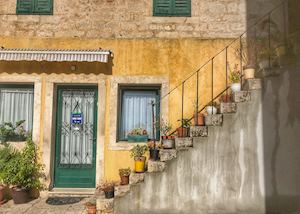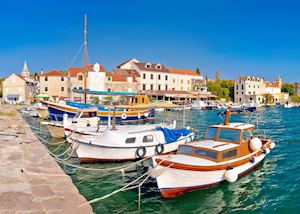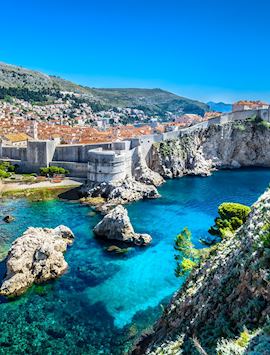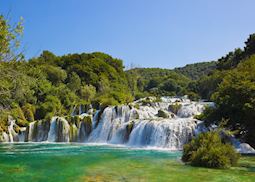Jump to:
Home to a restored historic core, Šibenik is little known outside Croatia and has yet to attract the crowds sometimes seen in Dubrovnik and Split. Set around a natural port, the city was founded in 1066 and by the 15th century was a prosperous mercantile hub at the heart of the Adriatic salt trade.
Today, its city walls and forts, cobblestone streets, waterfront promenade, and nearby islands exude an air of genuine authenticity, giving visitors a glimpse of everyday Croatian life in the most handsome of settings.
Croatia specialist CarolineIf you want to explore a well-preserved medieval city in Croatia, without the crowds, I suggest Šibenik. Not only is it less busy than Dubrovnik or Split, it also makes a good base for exploring nearby, lesser visited, local islands.
Things to see and do in Šibenik
Old Town
 The jumble of steep, narrow streets, sleepy lanes and stone steps that make up Šibenik’s old town are lined with traditional townhouses, their green and red shutters adding a dash of vibrancy to the quiet streets. Rather than a tourist attraction, the old town is lived in, children play on the laneways, people sit and chat in doorways and the smells of home cooking waft through the air.
The jumble of steep, narrow streets, sleepy lanes and stone steps that make up Šibenik’s old town are lined with traditional townhouses, their green and red shutters adding a dash of vibrancy to the quiet streets. Rather than a tourist attraction, the old town is lived in, children play on the laneways, people sit and chat in doorways and the smells of home cooking waft through the air.
It’s this sense of entering everyday life that sets Šibenik apart from Dubrovnik or Split, and wandering the quiet lanes inside the sturdy city walls you regularly happen upon small churches and squares, families getting their daily shopping and laundry hung out to dry.
Saint-James’s Cathedral
The old town’s most impressive building is the UNESCO-protected Saint-James’s Cathedral, a Gothic-Renaissance edifice completed in 1536. It’s considered the finest structure along the Dalmatian coast. The cathedral was designed by architect Juraj Dalmatinac and is constructed entirely from stone, no wooden supports or bricks were used in the massive cupola or barreled roof, just interlocking stone slabs.
The cathedral is a showcase for late-Medieval and early-Renaissance sculpture with a frieze of 71 stone heads depicting the 15th-century citizens of the town on the rear wall. The baptistry too is carved with an ornate ceiling and mischievous cherubs support the font.
Saint-Nicholas’s Fortress
As the importance of Šibenik grew in the 16th century, so did the threat of the Ottoman Empire encroaching from the east, and so a series of forts were constructed to protect the city. Triangular Saint-Nicholas’s Fortress was built to guard the maritime channel into the city and juts out into the water. Only a narrow walkway just above water level connects it to the land.
The fort is now a UNESCO World Heritage Site and inside the sturdy walls are 32 cannons that never saw action. It’s believed that the fort itself looked so impregnable that no one dared attack.
Saint-Michael’s Fortress
The oldest of Šibenik’s four fortresses, 11th-century Saint-Michael’s was once the seat of the Croatian king. It sits on top of a hill above the town and dominates the city skyline. It was most recently used as a defense post during the Croatian War of Independence, but has since been restored and converted into a summer concert venue.
With particularly fine acoustics, it makes an atmospheric backdrop to see a live performance. Even if you can’t make one of the special events, it’s worth climbing up to the battlements for views of the city and offshore islands, a vista that’s particularly impressive at sunset.
Island Hopping
 The glittering Adriatic plays a large part in Šibenik’s appeal but if you want to escape the city, it’s easy to visit nearby islands such as Zlarin, Prvić or Krapanj, where the pebbly beaches are never crowded. Prvić is the quietest of the three, home to fisherman and farmers, a few churches and a 15th-century Franciscan monastery.
The glittering Adriatic plays a large part in Šibenik’s appeal but if you want to escape the city, it’s easy to visit nearby islands such as Zlarin, Prvić or Krapanj, where the pebbly beaches are never crowded. Prvić is the quietest of the three, home to fisherman and farmers, a few churches and a 15th-century Franciscan monastery.
Zlarin has pebble beaches and hidden coves among its pine-forested shores and is known for its coral fishermen and traditional red necklaces, while on little Krapanj, diving for sea sponges has been a staple of the local economy since the 17th century. The island’s 16th-century Franciscan monastery contains a small museum telling the story of the divers.
Best time to visit Šibenik
Šibenik can be visited year round but summer heat and crowds mean that visits in July and August aren’t quite as pleasant as those between April and June or in September or October, when the weather is warm and dry and there are fewer people on the streets. Between November and March, the town is far quieter and many of the water-based activities are closed.
who's been there
-
617-223-4521617-223-4747
- Make an inquiry
Suggested itineraries featuring Šibenik
Our itineraries will give you suggestions for what is possible when you travel in Šibenik, and they showcase routes we know work particularly well. Treat them as inspiration, because your trip will be created uniquely by one of our specialists.
Places near Šibenik
- Trogir 24 miles away
- Šolta 31 miles away
- Split 32 miles away
- Zadar 43 miles away
- Brač 47 miles away
- Dalmatian Coast 48 miles away
- Hvar 55 miles away
- Korčula 76 miles away
- Plitviče Lakes 81 miles away
- Pula 129 miles away
- Dubrovnik 134 miles away
- Istria 141 miles away
- Zagreb 144 miles away
- Rovinj 146 miles away
Photos of Šibenik
Accommodation choices for Šibenik
We've selected a range of accommodation options for when you visit Šibenik. Our choices usually come recommended for their character, facilities and service or location. Our specialists always aim to suggest properties that match your preferences.
-
![D Resort Sibenik, Sibenik]()
D-Resort Šibenik
Šibenik
Ideas for experiencing Šibenik
Our specialists seek out authentic ways to get to know the places that could feature in your trip. These activities reflect some of the experiences they've most enjoyed while visiting Šibenik, and which use the best local guides.
-
Šibenik Islands like a local ![Local fishing boats in the bay, Zlarin]()
Šibenik Islands like a local
Šibenik Islands like a local
Little visited and full of character, the Šibenik Islands offer an insight into traditional life in Croatia. On this full-day tour, you’ll visit tiny villages of old stone houses, learn about political refuge and rebellion, and the local sea-sponge and coral industries.
View details -
Diocletian Palace walking tour ![Saint Domnius Cathedral, Split]()
Diocletian Palace walking tour
Diocletian Palace walking tour
Walk in the footsteps of Roman emperors, warriors and traders in the Diocletian Palace in Split. With a private guide, you’ll get expert commentary on the history, construction and preservation of the city and the lives of those who lived there.
View details -
Trogir with a local chef ![Local produce, Trogir]()
Trogir with a local chef
Trogir with a local chef
Explore the cobblestone streets and historic architecture of Trogir, tour its market with a local chef, and enjoy a five-course meal in the city’s botanic gardens on this unusual tour that offers a comprehensive overview of local history and culture.
View details -
Krka National Park visit and winery lunch ![Skradinski Buk, Krka National Park]()
Krka National Park visit and winery lunch
Krka National Park visit and winery lunch
On this full-day private tour, take in the karst scenery and gushing waterfalls of Krka National Park by boat before visiting a 15th-century monastery. Then, join the owners of a small vineyard on a tour of their estate before sitting down to a wine-paired lunch.
View details

















